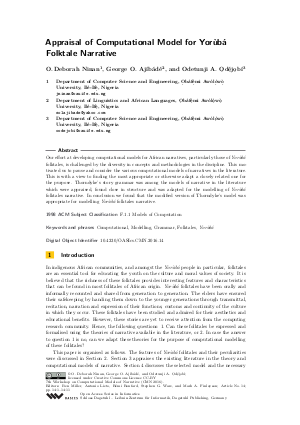Appraisal of Computational Model for Yorùbá Folktale Narrative
Authors O. Deborah Ninan, George O. Ajíbádé, Odetunji A. Odéjobí
-
Part of:
Volume:
7th Workshop on Computational Models of Narrative (CMN 2016)
Part of: Series: Open Access Series in Informatics (OASIcs) - License:
 Creative Commons Attribution 3.0 Unported license
Creative Commons Attribution 3.0 Unported license
- Publication Date: 2016-10-25
File

PDF
OASIcs.CMN.2016.14.pdf
- Filesize: 474 kB
- 11 pages
Document Identifiers
Subject Classification
Keywords
- Computational
- Modelling
- Grammar
- Folktales
- Yorùbá
Metrics
- Access Statistics
-
Total Accesses (updated on a weekly basis)
0PDF Downloads0Metadata Views
Abstract
Our effort at developing computational models for African narratives, particularly those of Yorùbá folktales, is challenged by the diversity in concepts and methodologies in the discipline. This motivated us to pause and consider the various computational models of narratives in the literature. This is with a view to finding the most appropriate or otherwise adapt a closely related one for the purpose. Thorndyke's story grammar was among the models of narrative in the literature which were appraised, found close in structure and was adapted for the modelling of Yorùbá folktales narrative. In conclusion we found that the modified version of Thorndyke's model was appropriate for modelling Yorùbá folktales narrative.
Cite As Get BibTex
O. Deborah Ninan, George O. Ajíbádé, and Odetunji A. Odéjobí. Appraisal of Computational Model for Yorùbá Folktale Narrative. In 7th Workshop on Computational Models of Narrative (CMN 2016). Open Access Series in Informatics (OASIcs), Volume 53, pp. 14:1-14:11, Schloss Dagstuhl – Leibniz-Zentrum für Informatik (2016)
https://doi.org/10.4230/OASIcs.CMN.2016.14
BibTex
@InProceedings{ninan_et_al:OASIcs.CMN.2016.14,
author = {Ninan, O. Deborah and Aj{\'\i}b\'{a}d\'{e}, George O. and Od\'{e}job{\'\i}, Odetunji A.},
title = {{Appraisal of Computational Model for Yor\`{u}b\'{a} Folktale Narrative}},
booktitle = {7th Workshop on Computational Models of Narrative (CMN 2016)},
pages = {14:1--14:11},
series = {Open Access Series in Informatics (OASIcs)},
ISBN = {978-3-95977-020-0},
ISSN = {2190-6807},
year = {2016},
volume = {53},
editor = {Miller, Ben and Lieto, Antonio and Ronfard, R\'{e}mi and Ware, Stephen G. and Finlayson, Mark A.},
publisher = {Schloss Dagstuhl -- Leibniz-Zentrum f{\"u}r Informatik},
address = {Dagstuhl, Germany},
URL = {https://drops.dagstuhl.de/entities/document/10.4230/OASIcs.CMN.2016.14},
URN = {urn:nbn:de:0030-drops-67158},
doi = {10.4230/OASIcs.CMN.2016.14},
annote = {Keywords: Computational, Modelling, Grammar, Folktales, Yor\`{u}b\'{a}}
}
Author Details
References
-
Noam Chomsky. On certain formal properties of grammars. Information and control, 2(2):137-167, 1959.

-
David K. Elson. Modeling Narrative Discourse. PhD thesis, Columbia University, 2012.

-
M. A. Finlayson. Learning narrative structure from annotated folktales. PhD thesis, Massachusetts Institute of Technology, 2011.

-
M. A. Finlayson, W. Richards, and P. H. Winston. Computational models of narrative: Review of a workshop. AI Magazine, 31(2):97, 2010.

- J. Kwiat. From aristotle to gabriel: A summary of the narratology literature for story technologies. Technical report, Knowledge Media Institute, The Open University, UK, 2008. URL: http://kmi.open.ac.uk/publications/pdf/kmi-08-01.pdf.
-
Aznar Carlos León. A computational model for automated extraction of structural schemas from simple narrative plots. PhD thesis, Universidad Complutense de Madrid, Servicio de Publicaciones, 2011.

-
Benedikt Löwe et al. Methodological remarks about comparing formal frameworks for narratives. In Third Workshop in the Philosophy of Information, Contactforum van de Koninklijke Vlaamse Academie van België voor Wetenschappen en Kunsten, pages 10-28, 2011.

-
Jean M. Mandler and Nancy S. Johnson. Remembrance of things parsed: Story structure and recall. Cognitive Psychology, 9(1):111-151, 1977.

- Utako K. Matsuyama. Can story grammar speak Japanese? The Reading Teacher, 36(7):666-669, 1983. URL: http://www.jstor.org/stable/20198301.
- D. O. Ninan and O. A. Odejobi. Towards a digital resource for african folktales. In Mark A. Finlayson, editor, CMN'12 Workshop on Computer Models of Narrative, pages 75-80, 2012. URL: http://narrative.csail.mit.edu/ws12/proceedings.pdf.
-
O. D Ninan. Formal Specification and Computational Modelling of African Folktale Narratives. Unpublished PhD. Thesis, Obafemi Awolowo University, Nigeria, 2015.

- Olufemi D. Ninan and Odetunji A. Odejobi. Theoretical issues in the computational modelling of Yorùbá narratives. In Mark A. Finlayson, Bernhard Fisseni, Benedikt Löwe, and Jan Christoph Meister, editors, 2013 Workshop on Computational Models of Narrative(CMN'13), pages 153-157. Schloss Dagstuhl - Leibniz-Zentrum für Informatik GmbH, Dagstuhl Publishing, Saarbrücken/Wadern, Germany, August 2013. URL: http://www.dagstuhl.de/oasics, URL: http://dx.doi.org/10.4230/OASIcs.CMN.2013.i.
-
Vladimir Propp. Morphology of the Folktale, volume 9. University of Texas Press, 1971.

-
E. C. Rowlands. The illustration of a Yorùbá proverb. Journal of the Folklore Institute, pages 250-264, 1967.

-
David E. Rumelhart. Notes on a schema for stories. Representation and understanding: Studies in cognitive science, 211:236, 1975.

-
Perry W. Thorndyke. Cognitive structures in comprehension and memory of narrative discourse. Cognitive psychology, 9(1):77-110, 1977.

-
Tzvetan Todorov and Arnold Weinstein. Structural analysis of narrative. In NOVEL: A forum on fiction, pages 70-76. JSTOR, 1969.

-
Kudakwashe Tuwe. The African Oral Tradition Paradigm of Storytelling as a Methodological Framework: Employment Experiences for African communities in New Zealand. In African Studies Association of Australasia and the Pacific (AFSAAP), February 2015.

- John M. Vlach. The fuctions of proverbs in Yorùbá folktales. Folklore Forum Bibliographic and Special Series, special series(11):31-41, 1973. URL: http://hdl.handle.net/2022/2576.
- G. P. Zarri. Representing and managing narratives in a computer-suitable form. In 2010 AAAI Fall Symposium Series, pages 73-80, 2010. URL: http://www.aaai.org/ocs/index.php/FSS/FSS10/paper/viewPDFInterstitial/2183/2819.
